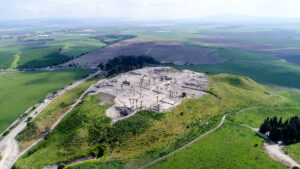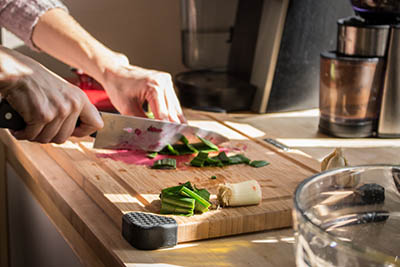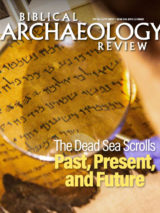The Vanilla Enigma: How a Canaanite Tomb Rewrote Spice History
World’s first use of Vanilla found at Tel Megiddo

Aerial view of Tel Megiddo in northern Israel, where the earliest evidence of the use of vanilla in the world was discovered. Courtesy Photo Companion to the Bible, Joshua.
What do you and a 3,600-year-old Canaanite have in common? You both have used vanilla. The discovery of vanilla-laced wine in Iron Age Jerusalem caused no small commotion. After all, vanilla was only domesticated in the 12th century CE, in Mesoamerica. So, how could the spice appear nearly two thousand years earlier and half a world away from where it was domesticated? This is where that 3,600-year-old Canaanite comes in. Located only fifty-five miles north of Jerusalem, and a thousand years earlier than the flavored wine found there, is the oldest known use of vanilla ever discovered, predating the plant’s Mesoamerican domestication by two and a half millennia.

FREE ebook: The Galilee Jesus Knew
As Canaanite as Vanilla
While analyzing the chemical residue left on a series of small pots from an elite burial tomb, dating to 1650–1550 BCE, the archaeological team made a startling discovery: significant amounts of vanillin, a primary flavor and aroma compound in vanilla. They also noticed several other chemical compounds known to come from true vanilla. Although vanilla might be no more than a cliché term for “common” or “unremarkable” today, this discovery was anything but. Found at the biblical site of Megiddo in northern Israel, the discovery goes against everything we thought we knew about vanilla and its origins. To get to the bottom of this conundrum, the team set out to figure out just what they had found.
In nature, trace amounts of vanillin can come from a wide range of sources, including some yeasts, fungi, and bacteria. It can even come from different aromatic resins, a few of which are native to the eastern Mediterranean. Yet, in each case, when compared to the results of their analysis, these other sources did not match the Megiddo samples. Even if the other sources contained vanillin, none of them had the full range of compounds found in the sample, and what they did have was not in the same ratios. Double-checking that their tests had not produced a faulty chemical signal due to contamination, the team came back to the seemingly impossible option: it was real vanilla. However, proving that what they found must be real vanilla was only part of the conundrum. How did it get to Megiddo?

FREE ebook, Recipes from the BAR Test Kitchen Make your own food from recipes handed down from biblical times. Download now.
Today, nearly all vanilla on the market can trace its origins back to a single species of vanilla orchid, vanilla planifolia. This plant was first cultivated in Mesoamerica around the 12th century, although wild vanilla was probably used in the area long before that. However, vanilla planifolia is not the only species of vanilla orchid. Indeed, various species of vanilla orchid are endemic to tropical regions across the globe, although only a handful are considered aromatic, and thus capable of producing what we know as vanilla. At least four of these are found outside of the Americas, with three species native to Southeast Asia and India, and one native to East Africa. Today, some local communities in these areas still grow or collect these vanilla orchids for use in food, medicines, and fragrances.

The orchid of vanilla planifolia, the primary species of vanilla in use today. Vanillinmacher, Attribution, via Wikimedia Commons
While these regions are still far away from the land of Canaan, by the second millennium BCE, many long-distance trade networks were already established, connecting the major urban centers of the day, including Egypt, Mesopotamia, Anatolia, and the Indus River Valley. Evidence of this far-reaching trade system can even be seen in the use of peppercorns from India in the mummification of Pharaoh Ramesses the Great. While the Levant was certainly not one of the great urban centers during this period, it had the fortune of being located along the trade routes running from Africa and Egypt to the rest of the Near East and beyond.
According to Vanessa Linares of the University of Haifa, lead author of the study, “Israel’s location at the crossroads of ancient trade routes likely facilitated the importation of exotic goods, including vanilla, from regions such as Southeast Asia or East Africa. The coastal and inland trade routes in Israel, such as those passing through Megiddo, would have made it an ideal location for the introduction and exchange of rare commodities like vanilla.”
Become a BAS All-Access Member Now!
Read Biblical Archaeology Review online, explore 50 years of BAR, watch videos, attend talks, and more

The tomb in which the vanilla was discovered was already a fantastic discovery due to its rich assemblage of material culture, including imported ceramics, jewelry, and other funerary offerings. But the vanilla was by far the most impressive find. It was likely used somehow in the funerary activities associated with the interment of the individuals laid to rest in the tomb, as vanilla combined its desirable fragrance with antifungal and antibacterial properties. As such, it might have been used for embalming, much like the Egyptian “scent of eternity,” which contained several similar compounds.
One question remains. With vanilla discovered in several archaeological contexts in Israel, why has it not been found elsewhere? “It’s important to consider the nature of the archaeological record and the specific trade routes that existed at the time,” said Linares. “Vanilla might have been imported and used in Israel due to its proximity to Egypt and other trading centers. Furthermore, organic residue analysis is still an under-researched field and is not automatically incorporated into every archaeological discovery. As the application of organic residue analysis becomes more routine in excavations around the world, we are likely to see an increasing number of exotic commodities like vanilla being identified in other regions.”
Related reading in Bible History Daily
Early Bronze Age: Megiddo’s Great Temple and the Birth of Urban Culture in the Levant
All-Access members, read more in the BAS Library
Not a BAS Library or All-Access Member yet? Join today.
Must-Read Free eBooks
Want more Bible history?
Sign up to receive our email newsletter and never miss an update.
Unlock Unlimited Access to the Bible's Past
Become an All-Access Member to explore the Bible's rich history. Get Biblical Archaeology Review in print, full online access, and FREE online talks. Plus, enjoy special Travel/Study discounts. Don't miss out—begin your journey today!












“World’s first use of Vanilla found at Tel Megiddo.” Since Vanilla clearly was not grown at Megiddo, and therefore came from somewhere else, where certainly it must have been used to flavor wines and other comestibles, how can its “first” use have been at Megiddo?
Thanks for asking. This is the earliest evidence of the use of vanilla discovered. It certainly was used earlier, but we do not have archaeological evidence for it.